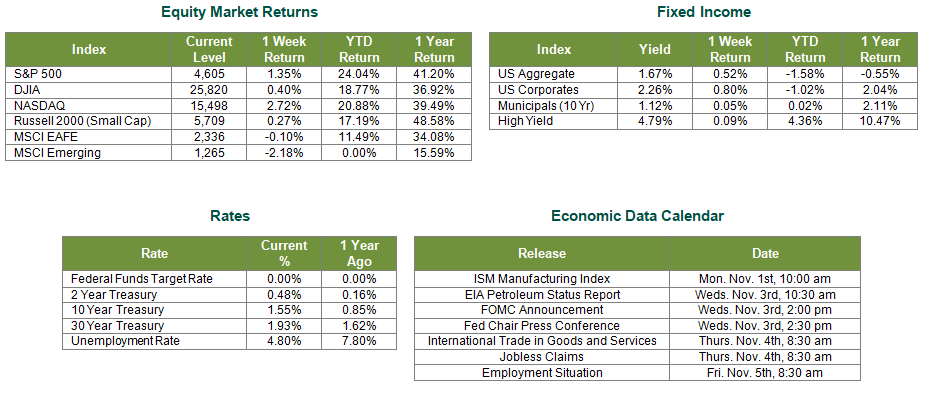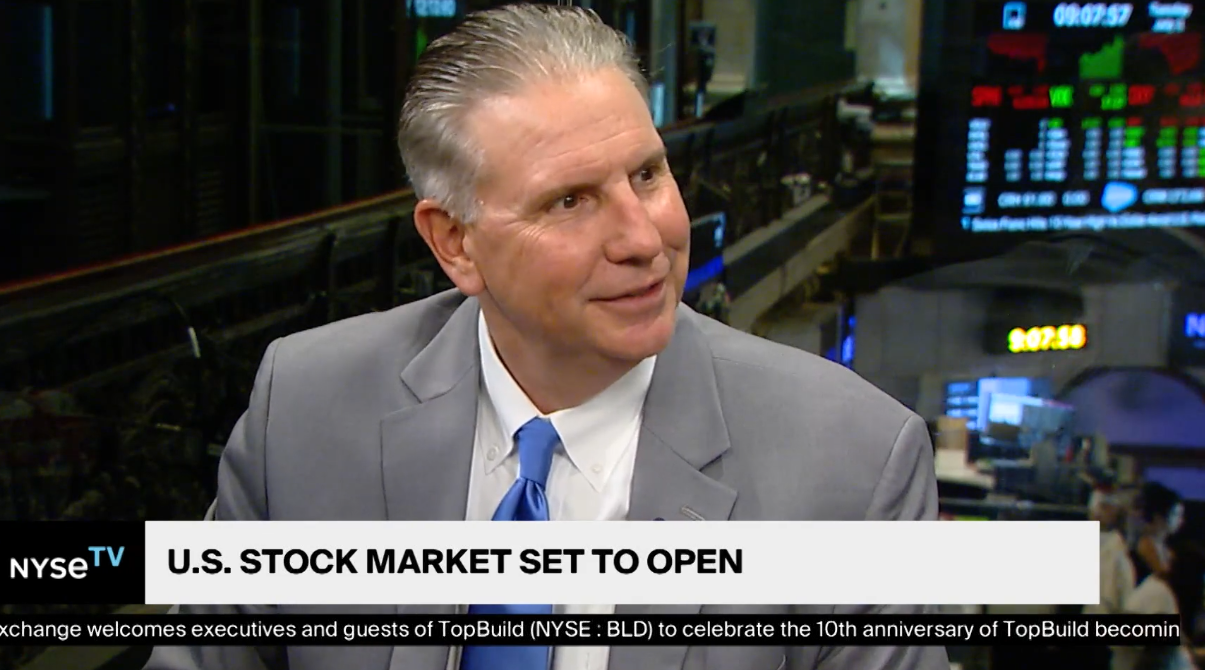
Last Week’s Markets in Review: Economy Slows as Earnings Grow in Q3

U.S. markets reached new all-time highs last week to close out the month. The S&P 500 Index closed the week at a level of 4,605, representing a gain of 1.35%, while the Russell Midcap Index moved 0.40% Lower. Meanwhile, the Russell 2000 Index, a measure of the Nation’s smallest publicly traded firms, returned 0.27% over the week. International equity performance wasn’t as encouraging as developed and emerging markets returned -0.10% and -2.18%, respectively. Finally, the 10-year U.S. Treasury yield moved 11 basis points lower over the week, closing at 1.55% on Friday.
Global equity markets came storming back in October following a lackluster September that led many to question the strength and direction of the economy and markets. In the U.S., the S&P 500 Index returned 7.01% for the month, representing the largest monthly gain in over a year, propelled by corporate profits this earnings season. Last week’s releases, highlighted by members of the FAANG party, followed the trend with the exception of two major players; Apple and Amazon, posting disappointing numbers, with each noting supply chain issues and uncertainties. Overall, with 56% of S&P 500 companies reporting actual results, 82% of S&P 500 companies have reported a positive EPS surprise and 75% of S&P 500 companies have reported a positive revenue surprise, according to FactSet. In addition, the blended earnings growth rate for the S&P 500 is 36.6%, compared to an initial estimate of 27.4%.
Strong earnings were vital for investors’ confidence in corporate America and the path of the economic recovery from the COVID-19 pandemic, particularly in the face of the advanced reading of third-quarter 2021 Gross Domestic Product (GDP) last Thursday. It was widely expected that the pace of the U.S. recovery slowed sharply in Q3 as consensus forecasts were for a growth rate of 2.6%, significantly lower than the 6.7% growth in Q2. The actual advanced reading of just 2% underperformed expectations but seemingly wasn’t enough to rattle investors. Supply chain bottlenecks, labor market issues, a slowdown in consumption, rising prices, and the impact of the Delta variant of COVID-19 were the primary drivers of the “soft” Q3 release. While these are material concerns, economists and strategists largely believe that the impacts will more so push GDP growth down the road, not diminish it entirely. According to Bloomberg, consensus expectations are for a bounceback in the fourth quarter of 2021 with a growth rate of 4.9% and a year-over-year GDP growth rate of 4% in 2022.
Earnings and GDP were only a slice of the key data to comb through last week. Below please find a table summarizing some of the more pertinent data points. Actual results beat expectations for the most part as jobless claims declined and consumer confidence and mortgage applications bounced back.

As always, we encourage investors to work with experienced financial professionals to help navigate the capital markets and build and manage the asset allocations within their portfolio strategies consistent with their objectives, timeframe, and tolerance for risk.
Best wishes for the week ahead!
Sources for data in tables: Equity Market and Fixed Income returns are from JP Morgan as of 10/29/21. Rates and Economic Calendar Data from Bloomberg as of 10/29/21. International developed markets measured by the MSCI EAFE Index, emerging markets measured by the MSCI EM Index, U.S. Large Cap defined by the S&P 500. Sector performance is measured using the GICS methodology.
Disclosures: Past performance does not guarantee future results. We have taken this information from sources that we believe to be reliable and accurate. Hennion and Walsh cannot guarantee the accuracy of said information and cannot be held liable. You cannot invest directly in an index. Diversification can help mitigate the risk and volatility in your portfolio but does not ensure a profit or guarantee against a loss.
Diversification can help mitigate the risk and volatility in your portfolio but does not ensure a profit or guarantee against loss.
Investing in commodities is not suitable for all investors. Exposure to the commodities markets may subject an investment to greater share price volatility than an investment in traditional equity or debt securities. Investments in commodities may be affected by changes in overall market movements, commodity index volatility, changes in interest rates or factors affecting a particular industry or commodity.
Products that invest in commodities may employ more complex strategies which may expose investors to additional risks.
Investing in fixed income securities involves certain risks such as market risk if sold prior to maturity and credit risk especially if investing in high yield bonds, which have lower ratings and are subject to greater volatility. All fixed income investments may be worth less than the original cost upon redemption or maturity. Bond Prices fluctuate inversely to changes in interest rates. Therefore, a general rise in interest rates can result in the decline of the value of your investment.
Definitions
MSCI- EAFE: The Morgan Stanley Capital International Europe, Australasia and Far East Index, a free float-adjusted market capitalization index that is designed to measure developed-market equity performance, excluding the United States and Canada.
MSCI-Emerging Markets: The Morgan Stanley Capital International Emerging Market Index, is a free float-adjusted market capitalization index that is designed to measure the performance of global emerging markets of about 25 emerging economies.
Russell 3000: The Russell 3000 measures the performance of the 3000 largest US companies based on total market capitalization and represents about 98% of the investible US Equity market.
ML BOFA US Corp Mstr [Merill Lynch US Corporate Master]: The Merrill Lynch Corporate Master Market Index is a statistical composite tracking the performance of the entire US corporate bond market over time.
ML Muni Master [Merill Lynch US Corporate Master]: The Merrill Lynch Municipal Bond Master Index is a broad measure of the municipal fixed income market.
Investors cannot directly purchase any index.
LIBOR, London Interbank Offered Rate, is the rate of interest at which banks offer to lend money to one another in the wholesale money markets in London.
The Dow Jones Industrial Average is an unweighted index of 30 “blue-chip” industrial U.S. stocks.
The S&P Midcap 400 Index is a capitalization-weighted index measuring the performance of the mid-range sector of the U.S. stock market, and represents approximately 7% of the total market value of U.S. equities. Companies in the Index fall between S&P 500 Index and the S&P SmallCap 600 Index in size: between $1-4 billion.
DJ Equity REIT Index represents all publicly traded real estate investment trusts in the Dow Jones U.S. stock universe classified as Equity REITs according to the S&P Dow Jones Indices REIT Industry Classification Hierarchy. These companies are REITs that primarily own and operate income-producing real estate.



